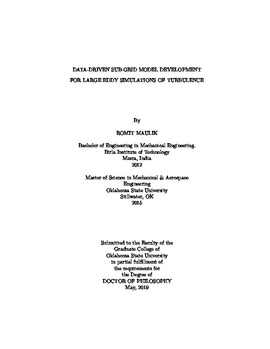| dc.contributor.advisor | San, Omer | |
| dc.contributor.author | Maulik, Romit | |
| dc.date.accessioned | 2020-04-09T20:53:41Z | |
| dc.date.available | 2020-04-09T20:53:41Z | |
| dc.date.issued | 2019-05 | |
| dc.identifier.uri | https://hdl.handle.net/11244/323826 | |
| dc.description.abstract | Turbulence modeling remains an active area of research due to its significant impact on a diverse set of challenges such as those pertaining to the aerospace and geophysical communities. Researchers continue to search for modeling strategies that improve the representation of high-wavenumber content in practical computational fluid dynamics applications. The recent successes of machine learning in the physical sciences have motivated a number of studies into the modeling of turbulence from a data-driven point of view. In this research, we utilize physics-informed machine learning to reconstruct the effect of unresolved frequencies (i.e., small-scale turbulence) on grid-resolved flow-variables obtained through large eddy simulation. In general, it is seen that the successful development of any data-driven strategy relies on two phases - learning and a-posteriori deployment. The former requires the synthesis of labeled data from direct numerical simulations of our target phenomenon whereas the latter requires the development of stability preserving modifications instead of a direct deployment of learning predictions. These stability preserving techniques may be through prediction modulation - where learning outputs are deployed via an intermediate statistical truncation. They may also be through the utilization of model classifiers where the traditional $L_2$-minimization strategy is avoided for a categorical cross-entropy error which flags for the most stable model deployment at a point on the computational grid. In this thesis, we outline several investigations utilizing the aforementioned philosophies and come to the conclusion that sub-grid turbulence models built through the utilization of machine learning are capable of recovering viable statistical trends in stabilized a-posteriori deployments for Kraichnan and Kolmogorov turbulence. Therefore, they represent a promising tool for the generation of closures that may be utilized in flows that belong to different configurations and have different sub-grid modeling requirements. | |
| dc.format | application/pdf | |
| dc.language | en_US | |
| dc.rights | Copyright is held by the author who has granted the Oklahoma State University Library the non-exclusive right to share this material in its institutional repository. Contact Digital Library Services at lib-dls@okstate.edu or 405-744-9161 for the permission policy on the use, reproduction or distribution of this material. | |
| dc.title | Data-driven sub-grid model development for large eddy simulations of turbulence | |
| dc.contributor.committeeMember | Jayaraman, Balaji | |
| dc.contributor.committeeMember | Santhanakrishnan, Arvind | |
| dc.contributor.committeeMember | Ku, Ja Eun | |
| osu.filename | Maulik_okstate_0664D_16102.pdf | |
| osu.accesstype | Open Access | |
| dc.type.genre | Dissertation | |
| dc.type.material | Text | |
| dc.subject.keywords | large eddy simulation | |
| dc.subject.keywords | machine learning | |
| dc.subject.keywords | turbulence modeling | |
| thesis.degree.discipline | Mechanical and Aerospace Engineering | |
| thesis.degree.grantor | Oklahoma State University | |
